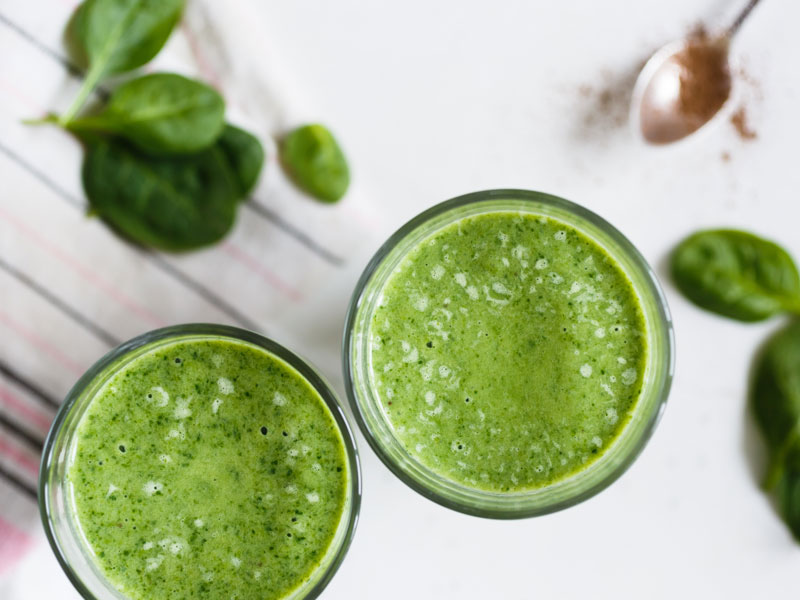Green smoothies. The holy grail of health. Yet they can pretty much suck right? We all want the health benefits that come with maximising on our greens but no one wants to chug down cold green sludge of a morning. Or even worse, cold khaki sludge.
Like all good cooking, when it comes to making smoothies, less is more. A broad spectrum of delicious constant variety is way more desirable than throwing all the ingredients at the glass every morning in a misguided bid to optimise our health.
But why are we so keen on greens in a glass anyway? What are the best greens for smoothies and how do we get them to taste good and avoid the dreaded sludge syndrome?
Eat your greens! Or better still, drink them.
Leafy greens are the original superfood. Of the top twenty most nutrient dense fruit and vegetables, seventeen are leafy greens. Whilst they share certain characteristics such as high chlorophyll content, each is unique in its power to support health and healing. Therefore the best plan of action is to consume a wide range of leafy greens at every available opportunity.
The best greens for smoothies are all particularly nutrient dense (low in calories and high in nutrients) because of their low sugar content. They come packed with certain groups of vitamins,minerals, and other beneficial plant compounds known as phytonutrients. Natural chemicals found in plants, phytochemicals are designed by nature to support the health of the plant yet most are hugely beneficial to human health too. The following phytonutrients are found in leafy green vegetables…
Carotenoids
A group of powerful antioxidant compounds that support the immune system, benefit eye heath and may reduce risk of cancer.
Beta carotene - the body converts this into Vitamin A.
Lutein and Zeaxanthin are both linked to reduced risk of macular degeneration (failing eyesight associated with aging).
Flavonoids
Also rich antioxidant compounds, they may help to reduce cancer and heart disease. Vital for healthy cell communication, flavonoids are detoxifying and can decrease inflammation.
The best greens for smoothies are also rich in certain vitamins and minerals, and fibre.
Vitamins
Vitamin A (converted from beta-carotene) - an antioxidant essential for vision, growth and reproduction, and production of collagen. Vitamin C - an antioxidant essential for a healthy immune system, healing, tissue strength and growth, and absorption of iron. Vitamin K - essential for blood clotting and metabolism of calcium. Helps to regulate blood sugar balance. Supports heart health and circulation. Folate - needed to create new blood cells, proteins, and DNA. Basically essential for growth.
Minerals
Magnesium - needed for energy production, muscle activity, and heart health. Iron - essential for healthy red blood cell function and energy release. Potassium - regulates blood pressure and water balance. Also involved in hormonal balance. Calcium - needed for healthy bones and teeth, regulates nerves and muscle function, regulates hormones and blood pressure.
Why smoothies?
Delicate nutrients can be destroyed during the cooking process so the best way to keep the nutritional profile intact is to consume greens raw. Not only does blitzing the nutrients down make them less bulky and therefore easier to eat more of, but the breaking down of the plant fibres makes these nutrients more easily available to the body. Unlike juicing, making a smoothie retains all the beneficial pulp and fibre.
What are the best greens for smoothies?
Although there are many different types of green vegetables, all of them bursting with benefits, some are more palatable in smoothies than others. Broccoli, for instance, has an impressive nutrient profile, but is strongly flavoured so can be hard to mask. Others, like spinach, blend really well and are milder in flavour.
Kale
A member of the cruciferous family, related to cabbage, broccoli and cauliflower, kale has powerful antioxidant properties. Rich in beta-carotene, vitamins C and K, and folate. Full of easily absorbed calcium and iron, kale is also an excellent source of chlorophyll.
Spinach
A member of the amaranth family, spinach is related to beets and quinoa. Packed with over a dozen different antioxidant flavonoids, spinach is a powerful anti-inflammatory. Rich in vitamin K, vitamin C and beta-carotene, as well as calcium, iron and potassium.
Top tips to make green smoothies taste good.

- Not only does fresh orange juice add a sweet sharp zing to a green smoothie, but it helps the body to absorb the mineral content too.
- Adding pineapple for sweetness also makes for quicker nutrient digestion.
- Apples and pears have a mild sweetness that pairs well with kale and spinach and keeps your smoothie looking fresh and green.
- The neutral flavour of cucumber works well with everything and its high water content adds to the liquid base.
- Use green powders to make life easier. Add a teaspoon or two of organic kale powder or spinach powder to your green smoothie ingredients. Or both.
- Go savoury. Use yoghurt as a base and add fresh herbs for a super savoury smoothie. Try a touch of garlic and a pinch of salt.
Check out the rest of our smoothie ingredients or head straight over to our bulk buy store.
The post The best greens for smoothies and how to make them taste good. appeared first on Boost Nutrients.

